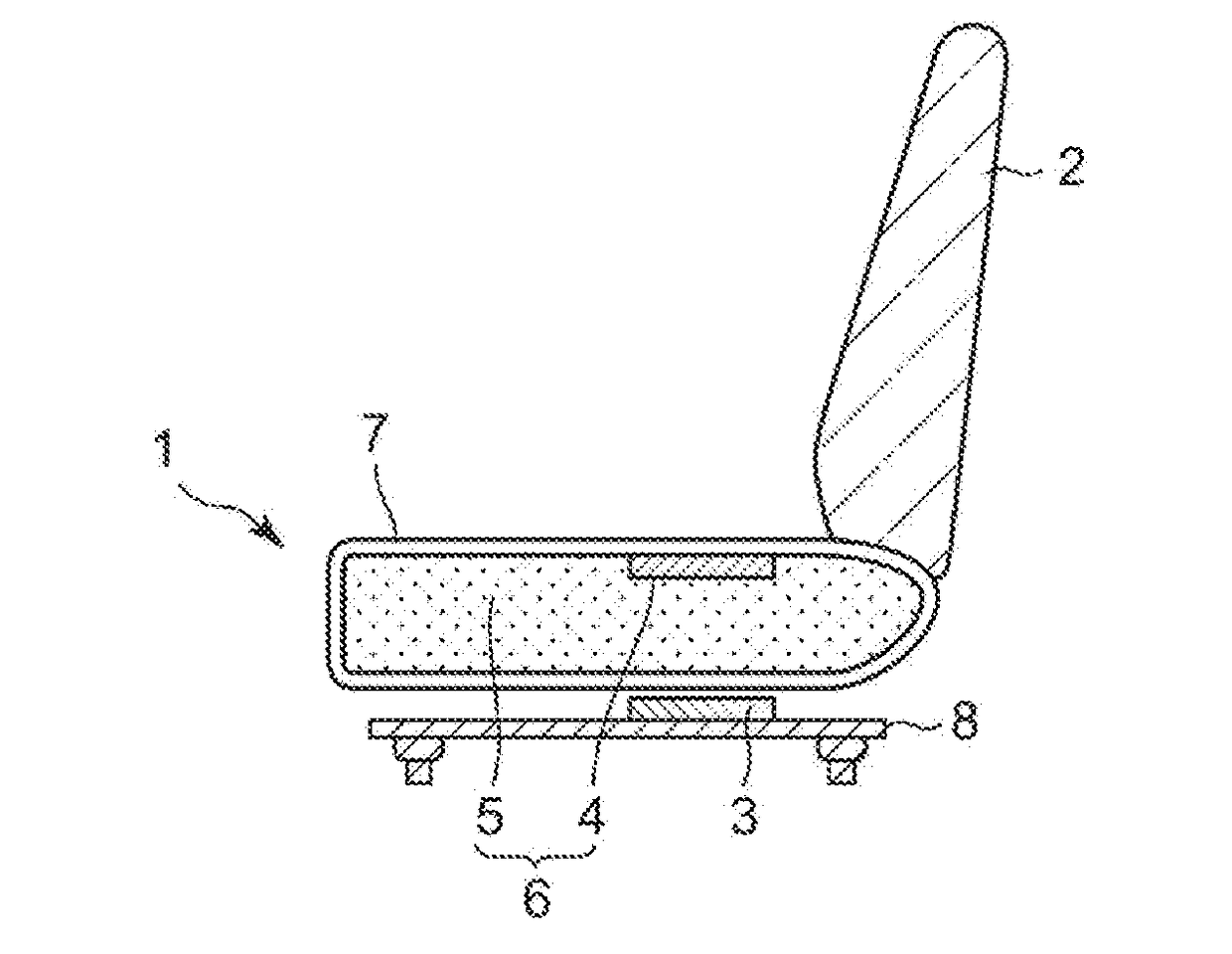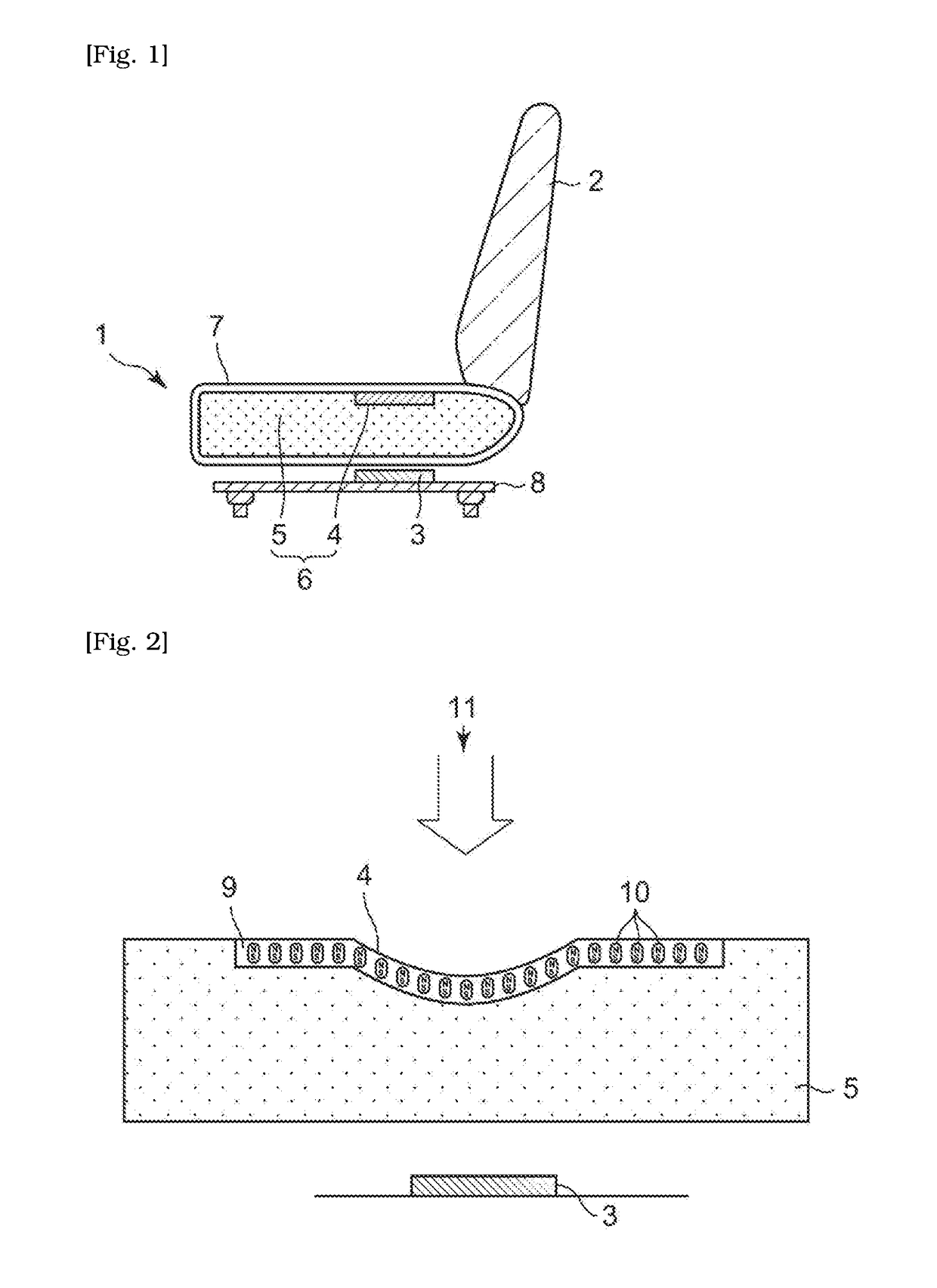System for detecting deformation of cushion pad and production thereof
a cushion pad and deformation technology, applied in the field of cushion pad deformation detection system, can solve the problems of difficult to prevent the sensation of foreign objects, give some durability problems, and difficulty in preventing foreign objects from feeling foreign, and achieve excellent durability, poor durability, and high self-adhesion ability.
- Summary
- Abstract
- Description
- Claims
- Application Information
AI Technical Summary
Benefits of technology
Problems solved by technology
Method used
Image
Examples
preparation example 1
Synthesis of Prepolymer A having Terminal Isocyanate End Group
[0084]A reaction vessel was charged with 85.2 parts by weight of polyol A (polyoxypropylene glycol obtained by adding propylene oxide to glycerin of an initiator, OH value 56 and functionality 3) and dehydrated at a reduced pressure with stirring for one hour. The reaction vessel was then changed to nitrogen atmosphere. Next, 14.8 parts by weight of toluene diisocyanate (2,4 configuration=100%, NCO %=48.3%; available from Mitsui Chemicals Inc.) was added to the reaction vessel and reacted for 3 hours at a temperature of 80° C. in the reaction vessel to synthesize a prepolymer A having a terminal isocyanate group (NCO %=3.58%).
preparation example 2
Synthesis of Prepolymer B having Terminal Isocyanate Group
[0085]A reaction vessel was charged with 81.2 parts by weight of polyol C (polyoxypropylene glycol obtained by adding propylene oxide to pentaerythritol of an initiator, OH value of 75 and functionality 3) and dehydrated at a reduced pressure with stirring for an hour. The reaction vessel was then changed to nitrogen atmosphere. Next, 18.8 parts by weight of toluene diisocyanate (2,4 configuration=100% and NCO %=48.3%) was added to the reaction vessel and reacted for 3 hours at a temperature of 80° C. to obtain a prepolymer B having a terminal isocyanate group (NCO %=4.55%).
example 1
[0086]A mixture solution of 213.0 parts by weight of polyol A and 0.38 parts by weight of bismuth octylate (PUCAT 25 available from Nihon Kagaku Sangyo Co., Ltd.) was mixed with 730.3 parts by weight of neodymium based filler (MF-15P available from Aichi Steel Corporation, average particle size=133 μm) to form a filler dispersion. The filler dispersion was defoamed in a reduced pressure and mixed with 100.0 parts by weight of the prepolymer A which has been defoamed, and then mixed using a planetary centrifugal mixer (available from Thinky Corporation) and defoamed. The reaction solution was poured dropwise on a PET film, which had been treated with a mold releasing agent and also had a spacer of 1.0 mm, and then was adjusted by a nip roller to a 1.0 mm thickness. It was then kept at 80° C. for 1 hour to cure, thus obtaining a magnetic filler dispersed polyurethane elastomer. The resulting elastomer was then magnetized at 1.3 T using a magnetizing apparatus (available from Denshijik...
PUM
 Login to View More
Login to View More Abstract
Description
Claims
Application Information
 Login to View More
Login to View More - R&D
- Intellectual Property
- Life Sciences
- Materials
- Tech Scout
- Unparalleled Data Quality
- Higher Quality Content
- 60% Fewer Hallucinations
Browse by: Latest US Patents, China's latest patents, Technical Efficacy Thesaurus, Application Domain, Technology Topic, Popular Technical Reports.
© 2025 PatSnap. All rights reserved.Legal|Privacy policy|Modern Slavery Act Transparency Statement|Sitemap|About US| Contact US: help@patsnap.com



